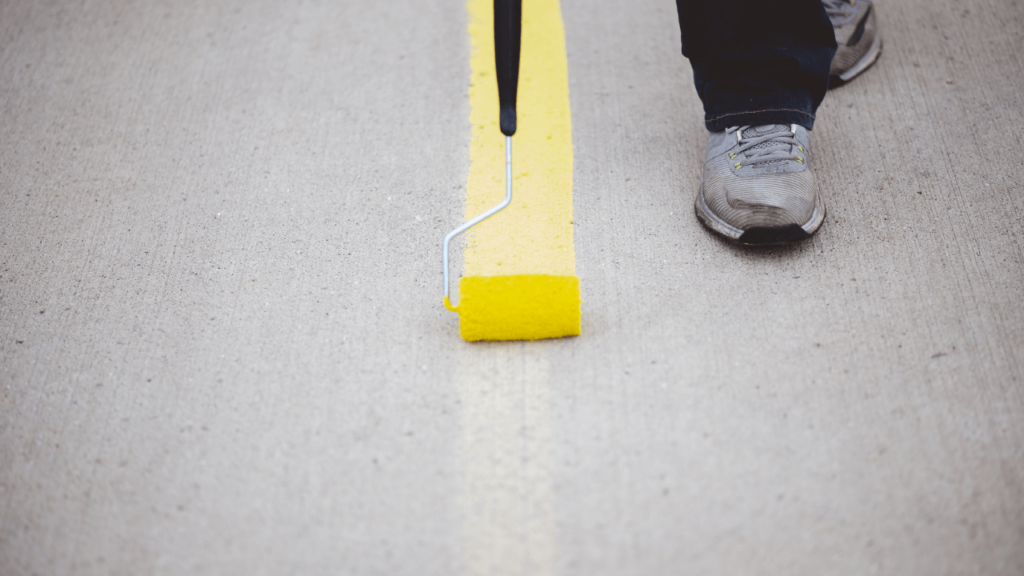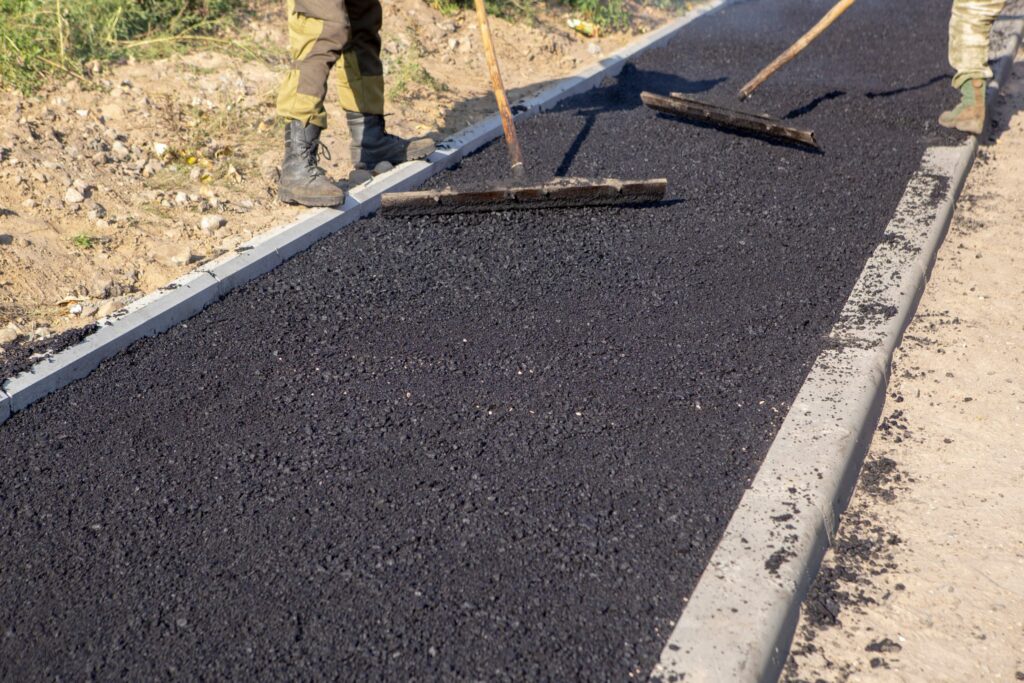Drivers, pedestrians, and bikers rely on road paint to guide them in navigating roads and their respective rules. Without paint, traffic would be chaotic. Road paint maintenance plays a crucial role in traffic management and in extending the life of traffic paint.
In this blog, we’ll discuss the lifespan of different types of road paint, the factors affecting their durability, and the maintenance procedures that help improve their durability.
How Long Does Road Paint Last?
There are different types of traffic paint and each one offers different features and lifespans.
Water-Based Road Paint
Water-based road paint is known for its quick-drying properties, making it a popular choice for road marking projects that need to be completed fast. However, its lifespan only ranges from six months to one year, so they require regular inspections and touch-ups.

Acetone
Acetone road paint is valued for its fast-drying nature, making it ideal for roads that cannot be closed for too long. This type of paint has excellent adhesion and durability, making it a great choice for high-traffic areas. It also exhibits good resistance to weather so it can last anywhere between one to two years.
Latex
This type of road paint is renowned for its durability and weather-resistant properties. Latex road paint also offers strong adherence to various surfaces, good color retention, and a lifespan of approximately one to three years.
It’s a popular choice for moderate traffic zones as they can provide long-lasting visibility and clear markings.
Thermoplastic
Thermoplastic road paint is the ideal choice for heavy-traffic areas and harsh climates. It has excellent wear-resistance and high reflectivity, so it’s also an excellent choice for areas with low-light conditions.
One of the top features of thermoplastic road paint is its long lifespan, which can last up to five years or longer. It also maintains optimal visibility with minimal maintenance and cleaning.

Factors Affecting Road Paint Longevity
While different types of road paint offer varying lifespans, external factors also contribute to how long road paint lasts. Consider these factors that affect traffic paint durability:
Traffic Volume
High-traffic areas experience quicker paint deterioration due to constant vehicle friction. Road paint in high-traffic areas, especially if it’s used by heavy vehicles, tends to fade faster.
Weather Conditions
Any type of extreme weather conditions can accelerate paint fading. UV rays, in particular, can cause paint to degrade. So, constant exposure to high UV levels contributes to faster fading.

Surface Type
The road surface also affects how well paint adheres to it. Smooth surfaces allow paint to adhere better and last longer compared to rough and uneven surfaces.
Paint Quality
The quality of paint used has a significant impact on the road paint’s durability since some paints are less durable than others.
Application and Maintenance
Different paint materials have specific application instructions and following that in addition to regular maintenance helps ensure that they last longer. Hire a company that can follow road paint application guidelines properly.
How to Make Road Paint Last Longer
The longevity of road paint depends on following the right application and maintenance processes.
Choosing the Right Type of Road Paint
Choosing the right type of road paint is the first step in ensuring its longevity. Consider the best type of paint for the surface, traffic volume, and climate.
Consider Compatibility with Climate
Climate and weather have a significant impact on road paint’s longevity since they are exposed to it all the time. It’s important to consider extreme temperatures, humidity levels, and exposure to UV and choose the paint that can withstand the type of weather conditions in the location.
Conduct Compatibility Check
To confirm which type of paint is the best choice for the location, it’s essential to conduct compatibility checks. This involves applying a small amount of paint to a test area so you can assess its adhesion, visibility, and durability.
This practice can help identify any compatibility issues so you can make the necessary adjustments before officially applying traffic paint on a larger scale.
For Fresh Asphalt
Freshly applied asphalt has unique characteristics since it has not been used yet. Follow these steps for applying paint on newly laid asphalt.

Follow the Waiting Period
It’s important to follow the waiting period when applying paint on freshly laid asphalt. The prescribed waiting period allows the asphalt to cure completely. In doing so, it also helps maximize the adhesion and durability of the road paint.
A typical waiting period lasts about 30 days.
Conduct Surface Check
It is best practice to conduct a surface check before applying paint on roads. The surface check means securing that there is no dust, dirt, or rocks on the road to be painted. These things could lead to uneven surfaces and reduce paint adhesion.
Apply High-Bonding Primer
A high-bonding primer further enhances the paint’s adhesion to roads, whether it’s asphalt or concrete. Primers serve as a protective barrier between the paint and any moisture on the road’s surface.
Use the Optimal Application Techniques
Following manufacturer guidelines, such as those regarding temperature, humidity, surface preparation, and application methods, ensures that the paint adheres properly and forms a durable layer. Improper application techniques can lead to premature paint wear and tear.
You can guarantee correct application by hiring a professional road paint maintenance service provider who is familiar with handling different paint materials and painting different road types.
For Existing Asphalt
Part of paint maintenance is reapplication, which involves painting over road that has been used and painted before. Here is the method to ensure that paint lasts longer:
Clean the Surface
Used roads have lots of dirt, dust, oil stains and various items stuck to them that can hinder paint adhesion. This is why thorough cleaning is a necessary step before applying new paint. Pressure washing or chemical cleaning and effectively remove these contaminants and reveal a clean and smooth surface that’s ideal for paint application.
Repair Any Issues
Another factor that can adversely affect paint adhesion to existing asphalt are cracks, potholes, and uneven surfaces from wear and tear. Repairing these issues ensures a stable and uniform surface, enhancing the durability of paint and maintaining clear markings longer.
Remove Old Paint
It’s best to apply paint on a clean canvas. This means that you need to remove old or faded paint before re-application. Some of the methods for paint removal include sanding or chemical stripping. Removing old paint not only improves adhesion for the new paint but also eliminates potential inconsistencies and improves the overall aesthetics of the road.

Maintaining Road Paint for Longevity
Here are essential road paint maintenance services to help maximize the lifespan of your traffic paint:
Regular Monitoring
Regular monitoring is key to maintaining the visibility and quality of road paint. Routine inspections allow for early detection of wear, fading, or damage, enabling timely interventions such as touch-ups or reapplication.
By implementing a proactive approach, you can help prevent extensive paint deterioration and ensure continuous visibility of road markings.
Routine Cleaning
Routine cleaning removes dirt, debris, and other contaminants that can affect road paint visibility. This practice can help maintain road paint’s effectiveness year after year, regardless of the traffic volume.
Scheduled Touch-Ups
Scheduled touch-ups are a preventive maintenance measure to address minor wear and tear before it becomes significant. This is especially true for durable paints like thermoplastic road paint.
Plan for periodic touch-ups based on traffic volume and paint condition to help maintain clear markings and visibility, especially in high-traffic areas where you expect higher paint wear and tear.
Prompt Reapplication
Timely reapplication of paint is key to balancing cost-effectiveness and successful traffic management. Identify faded or worn-out markings and schedule reapplication to rejuvenate their visibility.
One of the most effective ways to anticipate reapplication needs is the paint’s expected lifespan. Regular assessments of wear-and-tear also helps with efficient scheduling of reapplication.
A proactive approach is key to ensuring effective and legible road markings, which contribute to safer road conditions.
Improving Roads with Proper Road Paint Maintenance
By implementing these maintenance practices, road authorities can maximize the lifespan of road paint and ensure clear, durable markings that enhance traffic safety and guidance. Proactive road paint maintenance practices, such as regular monitoring, routine cleaning, scheduled touch-ups, and timely reapplication are essential for preserving the integrity and effectiveness of road markings over time.
Partner with Rua Seguridad for high-quality road paint application services that can help improve safety, reduce maintenance costs, and enhance overall road infrastructure quality.



